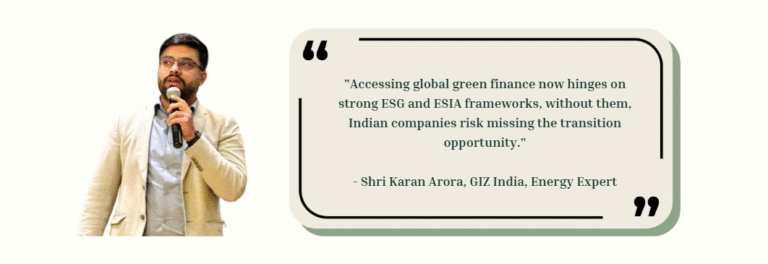

This session focused on unlocking the financial and regulatory architecture required to scale sustainable maritime infrastructure. With panellists from the renewable energy sector, global port developers, and strategic policy circles, the session highlighted following themes:
Green Fuel /Alternative Fuel Transition- Way Forward – Exploring strategies, technologies, and timelines for the adoption of low- and zero-carbon fuels such as green ammonia, methanol, LNG, hydrogen, and biofuels in India’s maritime sector.
Green Financing for a Sustainable Maritime Transition – Identifying financial instruments, climate bonds, ESG investments, and multilateral funding options for maritime decarbonisation.
Public-Private Partnerships for Sustainability -Models for risk-sharing, innovation scaling, and long-term collaboration between government, private players, and global institutions in green maritime initiatives.
Policy and Regulatory Framework for Fuel Transition and Financing – Establishing clear guidelines, incentives, and compliance mechanisms to support the shift to sustainable fuels and infrastructure.
International Best Practices in Fuel Transition and Maritime Financing – Case studies from other nations leading the way in maritime decarbonisation.
Readiness of adoption of Green Fuel /Alternative Fuel in Maritime Sector – Evaluating supply chain constraints, ship retrofitting issues, and port infrastructure limitations in accommodating new fuels.
Quantum of funds required for greening the maritime sector – Estimating capital needs for fleet conversion, fuel production and storage, port electrification, R&D, and training.
Sourcing of Finance – Mobilising funding through sovereign green bonds, MDBs, climate funds, CSR capital, and venture/impact investments.
Implementation of Carbon credits – Integrating maritime operations into national carbon markets and voluntary carbon credit mechanisms; evaluating the impact on business models.
Introduction of PPP for Green Projects – Addressing gaps in project preparation, bankability, and stakeholder engagement; ensuring long-term operational sustainability.








Shri Jeyanth Thomas, Secretary, Ship Agents Association
Shri Vaibhav Thakur, General Manager ESG and Green Energy, JM Baxi
Shri Gaurav Saxena, Director, PwC
Shri Preetish Biswal, Director, PwC
Shri Ashish Kulkarni, Partner, BCG
Shri Karan Arora, GIZ India, Energy Expert
Shri Senthil Subramanian, CEO, DBGT
Shri Subramanya Kanakatte, Country Head, RINA
This session touched upon one of the most crucial aspects of India’s maritime green transition focusing on how policy frameworks and financial mechanisms can support and accelerate decarbonisation across the shipping and port ecosystem. The speakers in this session represented industry associations, consulting firms, private enterprises and international cooperation agencies.
The session began with Shri Jayant Thomas, who brought in the perspective of small and medium enterprises and local businesses, those often excluded from high-level policy narratives. He noted that while India’s climate ambitions, including a 45% reduction in carbon intensity by 2030 and net zero by 2070, are globally commendable, the implementation landscape is fragmented and unclear for many operators. Green fuels such as hydrogen, ammonia and methanol remain conceptual for many players due to lack of commercial visibility, awareness and infrastructure. Even where green initiatives exist, such as hydrogen storage or EV logistics, these are rarely showcased or explained to the public, resulting in limited stakeholder engagement.
Furthermore, procurement decisions continue to be cost-driven, with green clauses in contracts often being token mentions in massive RFQs and do not impact final contract awarding, which is largely driven by reverse auctions and price undercutting. The high capital cost of green alternatives, like EV trucks being nearly three times more expensive than diesel vehicles, combined with an unresponsive supply chain makes the transition financially unviable without strong government support. He emphasised that the green transition must go beyond boardrooms and manifest in relatable, ground-level action, supported by tax breaks, procurement incentives and outreach to empower small operators.
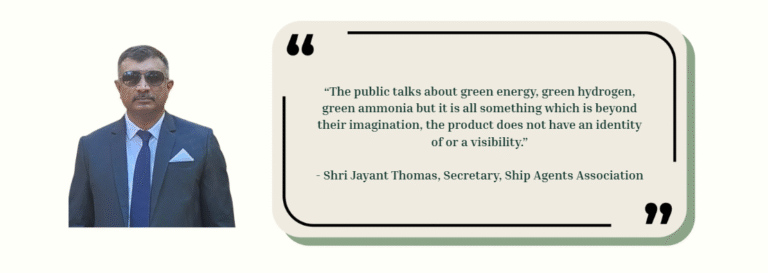
Shri Gaurav Saxena provided a global and policy-focused overview, outlining how international mandates like IMO 2023 and IMO 2025 are reshaping maritime emissions standards. Tools such as the Energy Efficiency Existing Ship Index (EEXI) and Carbon Intensity Indicator (CII) now mandate continuous improvement in fuel efficiency and emissions reduction. These frameworks set intermediate targets 20% emission reduction by 2030 and 70% by 2040, culminating in net zero by 2050. He further explained how shipping companies are responding with tiered strategies: short-term actions like route optimization and engine upgrades; mid-term retrofitting for alternative fuels; and long-term shifts toward hydrogen and ammonia-powered fleets.
He also highlighted the practicality of alternative fuels: biofuels suit older vessels due to minimal retrofitting, methanol is cost-effective and benefits from a growing supply chain, LNG acts as a transitional fuel and hydrogen along with ammonia are long-term bets requiring massive infrastructure investment. The vessel owners must thus assess alternative fuels based on parameters such as retrofit requirements, fuel cost, availability, infrastructure readiness and environmental performance. On the Indian front, he further underscored the role of MIV 2030, Harit Sagar Guidelines, and initiatives like Green Tugs and Green Shipping Corridors. These are backed by pilot projects focused on enabling bunkering infrastructure, cost-benefit analysis, and regulatory support. He stressed that such pilot projects are critical for validating green fuel technologies before national-scale deployment.
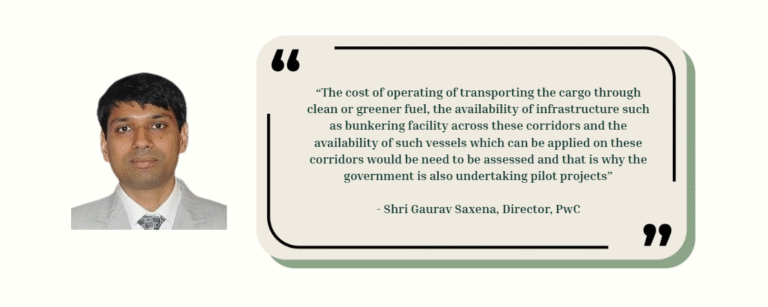
Shri Vaibhav Thakur provided valuable insights into how the private sector is increasingly aligning with ESG-driven transformation across the maritime value chain. He emphasised the growing commitment among industry players to decarbonisation across all three emission scopes. Electrification of cargo-handling equipment, such as Rubber Tyred Gantry Cranes and the adoption of battery-operated reach stackers, was highlighted as a key measure under Scope 1. For Scope 2, there is a visible shift toward renewable energy sources with several terminals now operating entirely on wind or a hybrid of solar and wind power. Addressing Scope 3 emissions, particularly those from logistics and transportation he pointed to the emerging use of electric trucks with swappable battery systems as a forward-looking solution.
He also underlined how social sustainability is becoming an integral part of port operations. A notable example is the Tuticorin Container Terminal, where women make up 50% of the workforce, an exceptional milestone that sets a benchmark for gender inclusion in the maritime sector. On the environmental front, the movement toward Zero Liquid Discharge (ZLD) systems and wastewater recycling in container freight stations reflects an increasing commitment to circular practices. Shri Thakur concluded by noting that many of these private sector efforts are now aligned with global frameworks as well as national priorities outlined in MIV 2030, indicating an integrated and future-ready ESG approach.
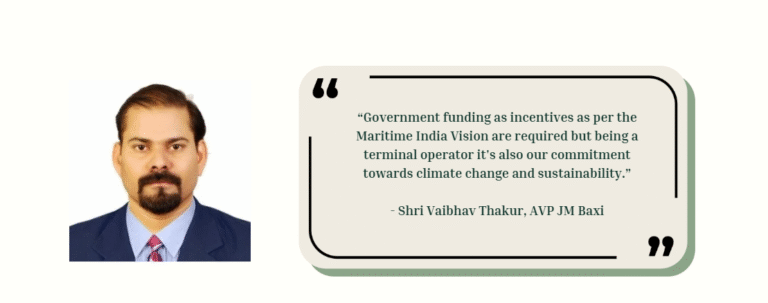
Shri Senthil Kumar addressed the financing dimension of the green transition, highlighting that ESG compliance is increasingly a prerequisite for investment. Institutional investors now incorporate ESG-readiness into due diligence, making regulatory clarity and finance access critical for companies. He noted that while various funding sources exist such as the ₹25,000 crore Maritime Development Fund, ₹16,000 crore Green Hydrogen Mission, and the IMO-led international decarbonisation fund much of it remains underutilized due to lack of awareness, technical capacity and support systems. Furthermore, tools like climate bonds, ESG-linked loans and blended finance models are emerging globally, but their application in India is still limited.
Subsidies such as a 30% capital grant for green vessels are available, yet financial institutions have been slow to engage. He stressed on the need for capacity building, especially for shipowners, port operators and hydrogen producers, to understand, access and manage green financing. With maritime trade accounting for 97% of India’s external cargo volume but only 300 internationally trading ships, the scope for green growth and strategic alignment with global finance trends is immense. As global shipping lanes increasingly transition to low-carbon operations, aligning with this shift is crucial for India to maintain trade competitiveness, attract sustainable finance and manage downstream impacts on consumer costs.
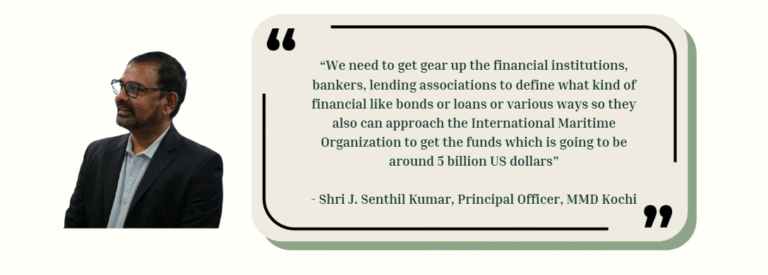
Shri Preetish Biswal added a perspective by framing decarbonisation across three interdependent pillars: technology, finance and regulation. Technological innovations like battery storage, CCUS and green fuels must be backed by scalability and affordability. He emphasized the role of carbon markets in improving project IRR through tradable credits and the need for blended finance models to mitigate investment risk. Regulatory clarity covering energy, shipping and carbon frameworks is essential for fostering investor confidence and ensuring predictability. He argued that government support is necessary but insufficient due to budgetary limitations and competing priorities. He expressed that the state must act as an ecosystem enabler by offering tax benefits, performance-linked incentives and risk guarantees. A coordinated approach, involving policy makers, financiers, technology providers, and international standards bodies is critical for building a sustainable maritime finance architecture.
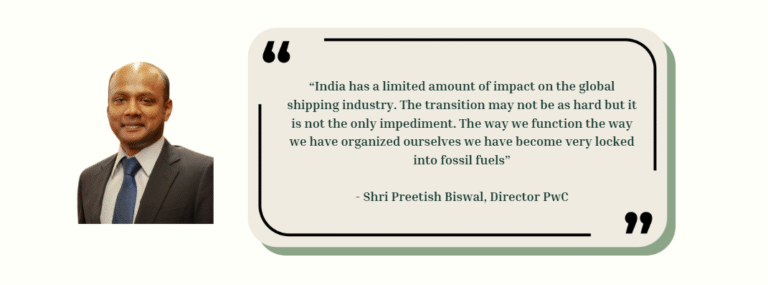
The session concluded with remarks from its last speaker in Shri Karan Arora who discussed the technical and regulatory bottlenecks hindering India’s green shipping ambitions. While shore-side electricity is emerging as a viable solution to reduce port emissions, India lacks standardised connectors and compatible equipment, risking non-compliance with international ships. Arora also drew attention to inconsistencies in certification standards India’s Green Hydrogen Certification Scheme, for example, uses different system boundaries than the EU’s RFNBO guidelines, which could pose challenges to cross-border green fuel trade. He emphasised the need for harmonised fuel standards, interoperable certification systems, and stable policy roadmaps that reduce uncertainty for port operators and vessel owners.
He further advocated for focused government investment in alternate fuel infrastructure and SSE at ports, alongside real-time guidance through workshops and capacity-building initiatives. According to him, while the government must build the foundation, private sector participation must be driven by market access benefits, ESG-linked performance incentives, and robust carbon pricing mechanisms.
